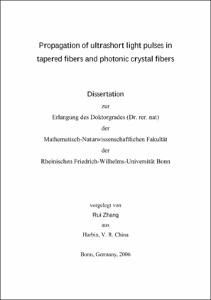Zhang, Rui: Propagation of ultrashort light pulses in tapered fibers and photonic crystal fibers. - Bonn, 2006. - Dissertation, Rheinische Friedrich-Wilhelms-Universität Bonn.
Online-Ausgabe in bonndoc: https://nbn-resolving.org/urn:nbn:de:hbz:5N-08619
Online-Ausgabe in bonndoc: https://nbn-resolving.org/urn:nbn:de:hbz:5N-08619
@phdthesis{handle:20.500.11811/2670,
urn: https://nbn-resolving.org/urn:nbn:de:hbz:5N-08619,
author = {{Rui Zhang}},
title = {Propagation of ultrashort light pulses in tapered fibers and photonic crystal fibers},
school = {Rheinische Friedrich-Wilhelms-Universität Bonn},
year = 2006,
note = {In this dissertation we studied the propagation characteristics of tapered fibers and photonic crystal fibers.
This thesis starts with the basic principles of linear and nonlinear optics, which are used to explain the generation mechanisms of supercontinuum radiation. Using a split-step Fourier method, the nonlinear Schrödinger equation is solved to simulate the spectral and temporal properties of the supercontinuum generation.
We simulated the evolution of the transverse intensity distribution, the nonlinear parameter γ, and the GVD of the fiber mode in the taper transition region of a tapered fiber. A complete model of propagation characteristics in tapered fibers was constructed.
In the design to tailor the group velocity dispersion of tapered fibers, we immersed the fibers in transparent liquids (such as acetonitrile, pentane, hexane, and liquid Series AAA from Cargille Labs). Spectrum simulations demonstrate that such a tapered fiber is capable to generate a supercontinuum with an extremely broadened spectrum, ranging from 700 nm to 2000 nm.
We designed a tapered fiber with elliptical cross section in the waist region, which maintains an incident linear polarization state throughout the propagation path and generates a highly polarized supercontinuum. The birefringence and group velocity dispersion as a function of wavelength of the fiber were calculated by using Mathieu functions. We designed a new nonlinear fiber to generate supercontinuum radiation with dramatically broadened spectrum by filling a highly nonlinear liquid into hollow photonic crystal fibers. The liquid-core photonic crystal fiber with carbon disulfide and nitrobenzene filled into the core exhibits an extremely high nonlinear parameter γ, which can be more than 20 times larger than that of a conventional PCF. Simulation shows that the spectrum generated by this new nonlinear fiber ranges from 700 nm to more than 3000 nm. In order to accomplish this task, we had to determine a complete quantitative response function in the femtosecond and picosecond regime for the first time.},
url = {https://hdl.handle.net/20.500.11811/2670}
}
urn: https://nbn-resolving.org/urn:nbn:de:hbz:5N-08619,
author = {{Rui Zhang}},
title = {Propagation of ultrashort light pulses in tapered fibers and photonic crystal fibers},
school = {Rheinische Friedrich-Wilhelms-Universität Bonn},
year = 2006,
note = {In this dissertation we studied the propagation characteristics of tapered fibers and photonic crystal fibers.
This thesis starts with the basic principles of linear and nonlinear optics, which are used to explain the generation mechanisms of supercontinuum radiation. Using a split-step Fourier method, the nonlinear Schrödinger equation is solved to simulate the spectral and temporal properties of the supercontinuum generation.
We simulated the evolution of the transverse intensity distribution, the nonlinear parameter γ, and the GVD of the fiber mode in the taper transition region of a tapered fiber. A complete model of propagation characteristics in tapered fibers was constructed.
In the design to tailor the group velocity dispersion of tapered fibers, we immersed the fibers in transparent liquids (such as acetonitrile, pentane, hexane, and liquid Series AAA from Cargille Labs). Spectrum simulations demonstrate that such a tapered fiber is capable to generate a supercontinuum with an extremely broadened spectrum, ranging from 700 nm to 2000 nm.
We designed a tapered fiber with elliptical cross section in the waist region, which maintains an incident linear polarization state throughout the propagation path and generates a highly polarized supercontinuum. The birefringence and group velocity dispersion as a function of wavelength of the fiber were calculated by using Mathieu functions. We designed a new nonlinear fiber to generate supercontinuum radiation with dramatically broadened spectrum by filling a highly nonlinear liquid into hollow photonic crystal fibers. The liquid-core photonic crystal fiber with carbon disulfide and nitrobenzene filled into the core exhibits an extremely high nonlinear parameter γ, which can be more than 20 times larger than that of a conventional PCF. Simulation shows that the spectrum generated by this new nonlinear fiber ranges from 700 nm to more than 3000 nm. In order to accomplish this task, we had to determine a complete quantitative response function in the femtosecond and picosecond regime for the first time.},
url = {https://hdl.handle.net/20.500.11811/2670}
}






